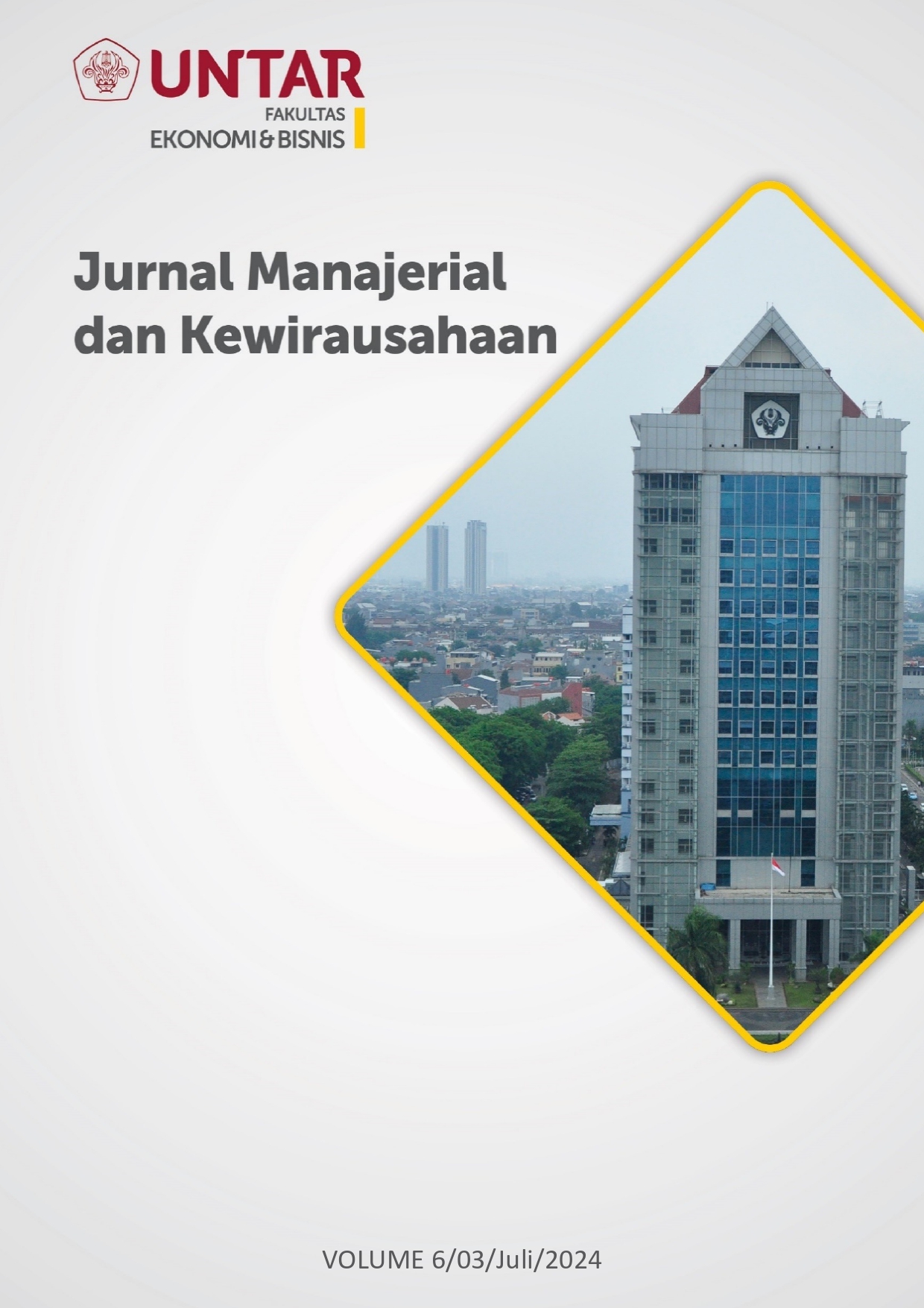Efek Pendidikan Kewirausahaan dan Media Sosial terhadap Intensi Berwirausaha Mahasiswa Manajemen UNTAR
Main Article Content
Abstract
This study aims to analyze the effect of entrepreneurship education and social media on entrepreneurial intentions in Tarumanagara University management students. The sample selection technique used in this study is probability sampling with a random sample method, ie all items in the population have an equal opportunity to be selected and become part of the sample. The sample in this study were management students who were pursuing undergraduate degrees at Tarumanagara University with a total of 169 respondents. The data were analyzed using the SEM method with the SmartPLS 4.0 application. The results of this study found a positive and significant effect of entrepreneurship education on entrepreneurial intention and social media has a positive and significant effect on entrepreneurial intention.
Article Details

This work is licensed under a Creative Commons Attribution-NonCommercial-ShareAlike 4.0 International License.
This work is licensed under a Jurnal Muara Ilmu Ekonomi dan Bisnis Creative Commons Attribution-ShareAlike 4.0 International License.,/p>
References
Ajzen, I. (1991). The Theory of Planned Behavior. Organizational Behavior and Human Decision Processes, 50(2), 179–211. https://doi.org/10.1016/0749-5978(91)90020-T
Arikunto, S. (2019). Prosedur Penelitian. Jakarta: Rineka Cipta.
Chandra, R. A. & Budiono, H. (2019). Pengaruh Pendidikan Kewirausahaan terhadap Niat Berwirausaha yang Dimediasi Efikasi Diri Mahasiswa Manajemen. Jurnal Manajerial dan Kewirausahaan, 1(4), 645-655. https://doi.org/10.24912/jmk.v1i4.6542
Cheung., Chi, K., & Chan, Y. C. R. The introduction of entrepreneurship education to school leavers in a vocational institute, vol 4, International Journal of Scientific Research in Education, 2011, pp. 8-16.
Chimucheka, Tendai. 2017. The Impact of Entrepreneurship Education on the Establishment and Survival of Small, Micro and Medium Enterprises (SMMEs). Journal Economics, 4(2): 157-168.
Hasan, I. (2019). Analisis pengaruh pertumbuhan ekonomi terhadap tingkat pengangguran terbuka di kabupaten nagan raya. Jurnal Ekombis, 4(2), 133-142.
Hidayati, N. (2015). “Faktor-Faktor Yang Berpengaruh Terhadap Keputusan Berwirausaha dan Dampaknya Terhadap Kualitas Hidup (Studi Terhadap Wanita Wirausaha Kuliner di Jawa Tengah)” Jurnal pendidikan, 3(1), 7-13.
Indraswati, Dyah, Vivi Rachmatul Hidayati, Nourma Pramestie Wulandari dan Mohammad Archi Maulyda. (2021). “Pengaruh Penggunaan Media Sosial Dan Lingkungan Keluarga Terhadap Minat Berwirausaha Mahasiswa PGSD Universitas Mataram. Jurnal Pendidikan Ekonomi dan Kewirausahaan, 9(1): 17–34.
John W. Creswell. Education Research, Planning, Conducting, and Evaluating Quantitative and Qualitative Research, (New Jersey USA: Pearson Education Inc., 2008), H.46
Kraus, S., Palmer, C., Kailer, N., Kallinger, F. L., & Spitzer, J. (2019), “Digital entrepreneurship: a research agenda on new business models for the twenty-first century”, International Journal of Entrepreneurial Behavior and Research, Vol. 25 No. 2, pp. 353-375.
Muhiba, F. N. (2020). Pengaruh Pendidikan Kewirausahaan dan Penggunaan Media Sosial Terhadap Minat Siswa Menjadi Entrepreneur RPL SMKN 9 Malang. 173.
Soelaiman, L., Herwindiati, D. E., & Payangan, O. R. (2023). Instagram vs TikTok: Platform Mana yang Lebih Efektif Meningkatkan Kinerja UMKM?. Jurnal Komunikasi, 15(2), 402-417. http://dx.doi.org/10.24912/jk.v15i2.236711
Souitaris, V. Zerbinati, S., & Al-Laham, A. 2007. Do entrepreneurship programmes raise entrepreneurial intention of science and engineering students? The effect of learning, inspiration and resources. Journal of Business Venturing, 22, pp: 566–591.
Tomy, S. & Pardede, E. (2020), “An entrepreneurial intention model focussing on higher education”, International Journal of Entrepreneurial Behavior and Research, Vol. 26 No. 7, pp. 1423-1447.
Tong X. A., Tong D. Y. K. & Loy L. C., (2011). Factors influencing entrepreneurial intention among university students. International Journal of Social Sciences and Humanity Studies, 3, 487- 496.



